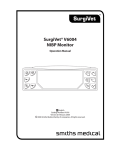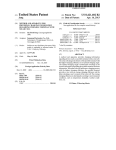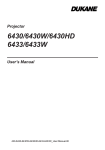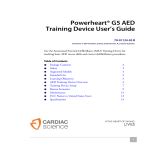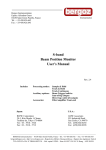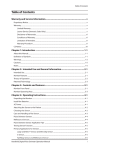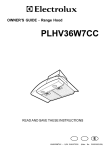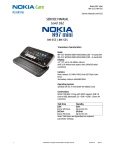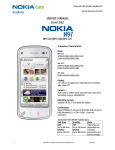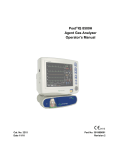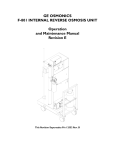Download SurgiVet V3404 ECG/Pulse Oximeter
Transcript
SurgiVet V3404 ECG/Pulse Oximeter Operation Manual SURGIVET, INC. N7 W22025 JOHNSON ROAD, SUITE A WAUKESHA, WI 53186 CATALOG NUMBER V1888 VERSION 3, OCTOBER 2001 ©2001, SURGIVET, INC. Table of Contents SurgiVet V3404 ECG/Pulse Oximeter Operations Manual Warranty & Service Information iv Proprietary Notice...................................................................................................................................................iv Limited Warranty....................................................................................................................................................iv Loaner Device (Domestic Sales Only) ...................................................................................................................iv Service Support.......................................................................................................................................................iv CE Notice .........................................................................................................................................................v 2 Warnings, Cautions, and Notes.........................................................................................................................vi Symbol Definitions .................................................................................................................................................vi General Warnings ............................................................................................................................................vi Cautions ...........................................................................................................................................................ix General Notes ...................................................................................................................................................x Chapter 1: Introduction 1-1 Intended Use: ....................................................................................................................................................... 1-1 Chapter 2: Description of Measurements, Controls and Features 2-1 General Description ............................................................................................................................................. 2-1 Front Panel........................................................................................................................................................... 2-3 EL Display ........................................................................................................................................................... 2-4 Keys ..................................................................................................................................................................... 2-5 Side Panel ............................................................................................................................................................ 2-6 Rear Panel............................................................................................................................................................ 2-7 Chapter 3: Setting Up the Monitor 3-1 Unpacking the Monitor and Checking the Shipment........................................................................................... 3-1 Turning Alarm and Alert Tones On and Off ....................................................................................................... 3-1 Working With Menus .......................................................................................................................................... 3-2 Menu Structure ............................................................................................................................................. 3-2 Freezing and Releasing Displayed Waveforms ................................................................................................... 3-3 Working With System-Wide Settings.................................................................................................................. 3-4 Setup/Volume Menu..................................................................................................................................... 3-4 Turning Parameter Monitoring On and Off.................................................................................................. 3-5 Adjusting Waveform Sweep Time, Size or Scales ....................................................................................... 3-5 Chapter 4: Alarms 4-1 High Priority Alarms ........................................................................................................................................... 4-1 Low Priority Alarms ............................................................................................................................................ 4-2 Working With the Alarms Menu ......................................................................................................................... 4-3 Adjusting or Viewing Alarm Limits............................................................................................................. 4-3 Alarm Tones ........................................................................................................................................................ 4-3 Turning Alarm and Alert Tones On and Off ................................................................................................ 4-4 System Information Signal: Low Battery ..................................................................................................... 4-4 SurgiVet V3404 Operation Manual i Table of Contents Chapter 5: ECG 5-1 Theory of Operation .............................................................................................................................................5-1 ECG Warnings, Cautions, & Notes ......................................................................................................................5-1 Using the ECG Parameter.....................................................................................................................................5-2 Setting Up ECG Monitoring.................................................................................................................................5-2 Attaching the Patient ............................................................................................................................................5-3 ECG Display.........................................................................................................................................................5-6 ECG Menu............................................................................................................................................................5-7 ECG Messages....................................................................................................................................................5-10 Alarm Messages ..........................................................................................................................................5-10 Status Message ............................................................................................................................................5-10 Chapter 6: Oximetry 6-1 General Description..............................................................................................................................................6-1 Pulse Oximetry Theory of Operation ...................................................................................................................6-1 Oximeter Display..................................................................................................................................................6-2 Oximeter Menu.....................................................................................................................................................6-3 Adjusting the Pulse Beep Volume........................................................................................................................6-4 Adjusting or Viewing the Averaging Settings......................................................................................................6-4 Oximeter Messages...............................................................................................................................................6-5 Alarm Messages ............................................................................................................................................6-5 Alert Messages ..............................................................................................................................................6-5 Messages .......................................................................................................................................................6-6 Attaching the Patient - Oximetry..........................................................................................................................6-6 Choose the Sensor .........................................................................................................................................6-6 Check Sensor Integrity ..................................................................................................................................6-7 Clean or Disinfect the Reusable Sensor ........................................................................................................6-7 Attach the Sensor to the Patient.....................................................................................................................6-8 Chapter 7: Trends 7-1 Trends Menu.........................................................................................................................................................7-2 Chapter 8: Serial Output 8-1 Serial Out Menu ...................................................................................................................................................8-1 Serial Output Setup For RS232 Connections .......................................................................................................8-2 Serial Output Setup For SurgiVet Graphics Printer .............................................................................................8-4 Output Examples: .................................................................................................................................................8-6 Patient Data ...................................................................................................................................................8-6 Trend Table Data...........................................................................................................................................8-7 Chapter 9: Analog Output 9-1 Analog Out Menu .................................................................................................................................................9-1 ii SurgiVet V3404 Operation Manual Table of Contents Chapter 10: Routine Maintenance 10-1 Operator’s Maintenance..................................................................................................................................... 10-1 Charging the Battery.......................................................................................................................................... 10-2 Cleaning and Disinfecting ................................................................................................................................. 10-2 Long Term Storage ..................................................................................................................................... 10-2 Chapter 11: Troubleshooting Appendices 11-1 Appendice-1 Appendix A: Supplies and Accessories ..................................................................................................Appendix-1 Appendix B: Specifications ....................................................................................................................Appendix-1 Parameters Monitored.............................................................................................................................Appendix-3 Graphics Display .............................................................................................................................Appendix-3 SpO2 ................................................................................................................................................Appendix-3 Pulse Strength ..................................................................................................................................Appendix-3 Pulse Rate ........................................................................................................................................Appendix-4 ECG .................................................................................................................................................Appendix-4 Heart Rate (ECG) ............................................................................................................................Appendix-4 Alarms/Alerts/Indicators..................................................................................................................Appendix-5 I/O's..................................................................................................................................................Appendix-6 Optional Printer and Serial Interface ...............................................................................................Appendix-6 Trend Storage ..................................................................................................................................Appendix-6 Sound Control..................................................................................................................................Appendix-6 Brightness Control...........................................................................................................................Appendix-6 Analog Outputs................................................................................................................................Appendix-7 Digital Alarm Output to Remote Sensing Location - Nurse Call ....................................................Appendix-7 Power...............................................................................................................................................Appendix-7 Environment ....................................................................................................................................Appendix-7 Physical............................................................................................................................................Appendix-7 Display.............................................................................................................................................Appendix-8 Keypad.............................................................................................................................................Appendix-8 List of Standards Applicable ...........................................................................................................Appendix-8 Equipment Classification.................................................................................................................Appendix-9 Calibration .......................................................................................................................................Appendix-9 SurgiVet V3404 Operation Manual iii CE Notice Warranty & Service Information Proprietary Notice Information contained in this document is copyrighted by SurgiVet, Inc. and may not be duplicated in full or part by any person without prior written approval of SurgiVet. Its purpose is to provide the user with adequately detailed documentation to efficiently install, operate, maintain and order spare parts for the device supplied. Every effort has been made to keep the information contained in this document current and accurate as of the date of publication or revision. However, no guarantee is given or implied that the document is error free or that it is accurate with regard to any specification. Limited Warranty SurgiVet, Inc. warrants each new device to be free from defects in workmanship and materials under normal use and service for a period of two (2) years from the date of shipment, and reusable oximetry sensors for a period of one (1) year from shipment (domestic sales only). SurgiVet’s sole obligation under this warranty will be to repair or replace, at its option, products that prove to be defective during the warranty period. The foregoing shall be the sole warranty remedy. Except as set forth herein, seller makes no warranties, either expressed or implied, including the implied warranties of merchantability and fitness for a particular purpose. No warranty is provided if the products are modified without the express written consent of SurgiVet, and seller shall not be liable in any event for incidental or consequential damage. This warranty is not assignable. Loaner Device (Domestic Sales Only) SurgiVet, Inc. will for the period of warranty make available at no charge, loaner devices if, in SurgiVet's opinion, the repair of the customer's device would require an unreasonable period of time. Service Support Repairs of SurgiVet's devices under warranty must be made at authorized repair centers. If the device needs repair, contact SurgiVet's service department or your local distributor to request a customer service report number (CSR). When calling, have the device’s model and serial number ready. NOTE: Shipments received without a CSR number will be returned to sender. If you need to ship the device, pack the device and its accessories carefully to prevent shipping damage. All accessories should accompany the device. SurgiVet, Inc. Attn: Service Department N7 W22025 Johnson Road, Ste A Waukesha, WI 53186 E-mail address: iv [email protected] Phone: (262) 513-8500 Toll-Free: (888) 745-6562 Fax: (262) 513-9069 Web Site: www.surgivet.com SurgiVet V3404 Operation Manual Warranty & Service Information CE Notice Marking by the symbol C0197 indicates compliance of this device to the Medical Device Directive 93/42/EEC. Authorized Representative (as defined by the Medical Device Directive): MedPass International Mendelstrasse 18A 86415 Mering-Munich, Germany SurgiVet V3404 Operation Manual Phone: (49) 8233-31590 Fax: (49) 8233-32462 v Warnings, Cautions, and Notes 2 Warnings, Cautions, and Notes KEYWORD DEFINITION WARNING Tells you about something that could hurt the patient or hurt the operator. CAUTION Tells you about something that could damage the monitor. NOTE Tells you other important information. Symbol Definitions SYMBOL q DEFINITION Defibrillator-proof type CF equipment Type CF equipment. 2 T 7 G D E IPX1 F B 0 Attention, consult accompanying documents. Class II device Refer servicing to qualified service personnel. Direct Current Output voltage Input voltage Drip Proof Printer output Alarm Silence Loudspeaker General Warnings WARNING: Federal law (USA) restricts the use or sale of this device by, or on the order of, a licensed veterinarian. WARNING: Do not use this device in the presence of flammable anesthetics. WARNING: Do not autoclave, ethylene oxide sterilize, or immerse in liquid. Unplug before cleaning or disinfecting. WARNING: ELECTRICAL SHOCK HAZARD when cover is removed. Do not remove covers. Refer servicing to qualified personnel. WARNING: Do not use this device in the presence of magnetic resonance imaging (MR or MRI) equipment. vi SurgiVet V3404 Operation Manual Warnings, Cautions, and Notes WARNING: Do not plug the monitor into an outlet controlled by a wall switch. WARNING: This device must be used in conjunction with clinical signs and symptoms. This device is only intended to be an adjunct in patient assessment. WARNING: In the event that earth ground integrity is lost, the performance of this device and/or other devices nearby may be affected due to excessive RF emissions. WARNING: When connecting this monitor to any instrument, verify proper operation before clinical use. Refer to the instrument’s user manual for full instructions. Accessory equipment connected to the monitor’s data interface must be certified according to the respective IEC standards, i.e., IEC 950 for data-processing equipment or IEC 601-1 for electromedical equipment. All combinations of equipment must be in compliance with IEC 601-1-1 systems requirements. Anyone connecting additional equipment to the signal input port or signal output port configures a medical system, and, therefore, is responsible that the system complies with the requirements of the system standard IEC 601-1-1. WARNING: Where HF (diathermy) is used there is no danger of burning to the patient provided recommended components are used. Rate meters may be temporarily affected. WARNING: Equipment is protected against defibrillator discharge. Rate meters and displays may be temporarily affected during defibrillation, but will rapidly recover. WARNING: Any monitor that has been dropped or damaged should be checked by a qualified service personnel to insure proper operation prior to use. WARNING: This monitor will not operate effectively on patients who are experiencing convulsions or tremors. Oximetry WARNING: Use only SpO2 sensors supplied with, or specifically intended for use with, this device. WARNING: Prolonged use or the patient’s condition may require changing the sensor site periodically. Change sensor site and check skin integrity, circulatory status, and correct alignment at least every 4 hours. WARNING: When attaching SpO2 sensors with Microfoam® 1 tape, do not stretch the tape or attach the tape too tightly. Tape applied too tightly may cause inaccurate readings and blisters on the patient's skin (lack of skin respiration, not heat, causes the blisters). 1 Microfoam® is a registered trademark of the 3M Company. SurgiVet V3404 Operation Manual vii Warnings, Cautions, and Notes ECG WARNING: PACEMAKER PATIENTS. Rate meters may continue to count the pacemaker rate during occurrences of cardiac arrest or some arrhythmias. Do not rely entirely upon rate meter alarms. Keep pacemaker patients under close surveillance. See this manual for disclosure of the pacemaker pulse rejection capability of this instrument. WARNING: PACEMAKER PATIENTS: If PACE DETECT is not turned on when monitoring pacemaker patients the heart rate readouts derived from the ECG patient connections are likely to display erroneous high or erratic rates. Keep pacemaker patients under close surveillance. For pacemaker patients it may be advisable to select the SpO2 parameter as the primary heart rate source. WARNING: Connect only three-lead or five-lead ECG lead wires from the patient to the ECG patient cable. Do not connect any other signal source to the ECG patient cable. WARNING: False low heart rate indicators or false Asystole calls may result with certain pacemakers because of electrical overshoots. WARNING: Reliable monitoring of pacemaker patients can only occur with the pace detect on. WARNING: The pacemaker spike shape and size is not to be diagnostically interpreted. WARNING: Keep pacemaker patients under close observation. Rate detection in the software may continue to count the pacemaker rate during cardiac arrest and/or arrhythmia conditions. Therefore, do not rely solely on rate detection alarms. WARNING: Do not use line isolations transformers with this monitor. Line isolation monitor transients may resemble actual cardiac waveforms and thus inhibit heart rate alarms. WARNING: Electrodes of dissimilar metals should not be used. viii SurgiVet V3404 Operation Manual Warnings, Cautions, and Notes Cautions CAUTION: Ensure the device’s AC rating is correct for the AC voltage at your installation site before using the monitor. The monitor’s AC rating is shown on the external power supply. If the rating is not correct, do not use the monitor; contact SurgiVet’s service department for help. CAUTION: Should the device become wet, wipe off all moisture and allow sufficient time for drying before operating. CAUTION: This device is intended for use by persons trained in professional health care. The operator must be thoroughly familiar with the information in this manual before using the monitor. CAUTION: Do not allow water or any other liquid to spill onto the monitor. Unplug the external power supply from the monitor before cleaning or disinfecting the monitor. CAUTION: Pressing front panel keys with sharp or pointed instruments may permanently damage the keypad. Press front panel keys only with your finger. CAUTION: Do not disassemble unit. This unit is not user serviceable. Refer to qualified service personnel. CAUTION: Ensure conductive parts including electrodes of the patient cable do not come into contact with any conductive surfaces or earth parts. CAUTION: It is the operator’s responsibility to set alarm limits appropriately for each individual patient. CAUTION: If the accuracy of any measurement is in question, check the patient’s vital sign(s) by an alternative method and then check the monitor for proper functioning. CAUTION: The monitor should be operated from its internal power source (if fitted) if the integrity of the protective earth conductor is in doubt. CAUTION: Follow local governing ordinances and recycling instructions regarding disposal and recycling of device components. CAUTION: The monitor contains a 1.2 hour lead-acid battery. If the battery fails to hold a charge or otherwise become inoperable, the battery should be replaced and the old battery should be disposed of properly. Lead-acid batteries should not be disposed of in normal trash containers. They should be sent to the proper facilities so that the metals in them may be reclaimed and/or recycled. Lead-acid battery: In the US, 1-800-822-8837 will provide information about the proper disposal of the lead-acid battery. Regulations in Europe vary from country to country. Consult local authorities for information about proper disposal. SurgiVet, Inc. cannot dispose of monitor batteries. SurgiVet V3404 Operation Manual ix Warnings, Cautions, and Notes General Notes NOTE: Operation of this device may be adversely affected in the presence of strong EM or RF sources, such as electrosurgery equipment. NOTE: Operation of this device may be adversely affected in the presence of computed tomograph (CT) equipment. NOTE: The monitor is protected against damage from defibrillator, diathermy, and electrocautery discharge. NOTE: All user and patient accessible materials are non-toxic. NOTE: Hazards arising from software errors have been minimized. Hazard analysis was performed to meet prEN1441: 1994. NOTE: Each input and output connection of the monitor is electrically isolated. Connection of this monitor to other equipment will not increase leakage current. ECG NOTE: Follow institutional standards when applying ECG electrodes. Silver/Silver Chloride disposable electrodes are strongly recommended to avoid polarization effects that result in large input offset potentials. Use of “squeeze bulb” type electrodes is not recommended. NOTE: Use only standard AAMI three-lead or five-lead ECG cables. NOTE: The ECG patient circuit is electrically isolated. Oximetry NOTE: Dyes introduced into the bloodstream, such as methylene blue, indocyanine green, indigo carmine, patent blue (PBV), and fluorescein, may cause an inability to determine accurate SpO2 readings. NOTE: Any condition that restricts blood flow, such as use of a blood pressure cuff or extremes in systemic vascular resistance, may cause an inability to determine accurate pulse and SpO2 readings. NOTE: Significant levels of dysfunctional hemoglobins, such as carboxyhemoglobin or methemoglobin, will affect the accuracy of the SpO2 measurement. NOTE: SpO2 measurements may be adversely affected in the presence of high ambient light. If necessary, shield the sensor area (with a surgical towel, for example). x SurgiVet V3404 Operation Manual Chapter 1: Introduction Chapter 1: Introduction Intended Use: The SurgiVet V3404 ECG/Pulse Oximeter is a low cost portable ECG and oximetry monitor. It noninvasively and continuously monitors and displays arterial blood oxygen saturation of arterial hemoglobin (SpO2), pulse rate, plethysmogram and ECG waveforms. It may be used in the veterinary hospital or clinical environment. The oximetry feature works with all SurgiVet oximetry sensors, providing SpO2 and pulse rate on all patients. The SurgiVet V3404 ECG/Pulse Oximeter permits continuous patient monitoring with adjustable alarm limits for oximetry and ECG, as well as visible and audible alarm signals. SurgiVet V3404 Operation Manual 1-1 Chapter 2: Description of Measurements, Controls and Features Chapter 2: Description of Measurements, Controls and Features General Description FIGURE 2.1: GENERAL DESCRIPTION Parameters: The SurgiVet V3404 ECG/Oximeter is an ECG and oximetry monitor. Alarm limits can be set on all monitored parameters. ECG: The monitor continuously measures and displays an ECG waveform. Either 3 or 5 lead monitoring may be selected. The monitor beeps with each heart beat. The volume of the heart beat is adjustable. The pitch of the heart beat varies with the heart rate value. Oximeter: The monitor continuously measures and displays arterial blood oxygen saturation (SpO2) and Pulse Rate (HR). Oximetry includes the display of a plethysmogram and pulse strength bar. The monitor beeps with each pulse beat. The volume of the pulse beep is adjustable. The pitch of the pulse beep varies with the SpO2 value. A variety of veterinary reusable sensors are available for monitoring patients. Audio: The monitor uses a multi-frequency speaker for beeps and alarm/alert sounds. Volumes are adjustable. SurgiVet V3404 Operation Manual 2-1 Chapter 2: Description of Measurements, Controls and Features 2-2 Serial Output: An RS-232C interface allows serial output of text data to either a PC or a compatible serial printer. Waveforms may be output only if the monitor is attached to an optional SurgiVet graphics printer. Analog Outputs: There are two analog channels with user-selectable outputs of waveform or parameter data, or calibration signals. Power: The SurgiVet V3404 operates on power from an external power supply. In addition, the monitor contains an internal battery which will allow operation for approximately 1.5 hours. SurgiVet V3404 Operation Manual Chapter 2: Description of Measurements, Controls and Features Front Panel % SpO2 I I BPM FIGURE 2.2: FRONT PANEL 1. EL Panel The electroluminescent display (EL) provides continuous, real-time updates of one or two waveforms or measurement trends, and alarm or alert messages. The display also shows menus and a pulse strength bar. 2. Display LED’s The display LED’s provide continuous, real-time updates of oximetry values: % SpO2 and pulse rate (sBPM). If the s BPM source is set to ECG in the SETUP/VOLUME menu, the display LED for sBPM will show a heart rate value. 3. Charge LED (green) Is on steady while external power is applied and battery is fully charged. Indicates battery is charging by blinking very slowly while external power is applied. If there is no external power, then this LED is off. 4. ALARM LED This ALARM indicator flashes during patient alarms. (red) 5. ALERT LED This ALERT indicator flashes during a system alarm, but remains on (yellow) steady if there is no system alarm and a low battery condition exists. 6. Keys SurgiVet V3404 Operation Manual The front panel keys control the monitor's functions. Dedicated keys are provided for turning the monitor on and off, silencing alarm and alert tones, selecting waveforms or trends, and selecting menus. 2-3 Chapter 2: Description of Measurements, Controls and Features EL Display 4 2 5 I I 1 3 FIGURE 2.3: EL DISPLAY 1. Pulse Bargraph The pulse signal strength is displayed here on a 10 segment bargraph. 2. Message Area Messages for alarms, alerts, and system information are displayed here on two lines. If more than one message must be displayed on the same line, then they alternate once per second. 3. Waveforms Trends, Menus One or two waveforms are displayed here. A trend graph or a menu can be displayed in place of waveforms. 4. Alarm Silence Indicator 5. ECG Pulse Rate Indicator 2-4 Flashes during two-minute alarm silence. Stays on steady during indefinite alarm silence. If alarms are not silenced the indicator stays on steady and appears without the slash. This indicator is displayed next to the alarm silence indicator. The indicator blinks with each heart beat. SurgiVet V3404 Operation Manual Chapter 2: Description of Measurements, Controls and Features Keys 3 5 2 4 1 FIGURE 2.4: KEYS 1. L STANDBY/ON Pressing L switches the monitor between ON (monitoring a patient) and STANDBY (monitor off, but power is applied if the green indicator is lit.). 2. a WAVE/TREND This key controls the waveform area display. Press this key to display the ECG wave by itself, the plethysmogram by itself, or both ECG and the oximeter's plethysmogram, or a trend. Press a while menus are displayed for a quick menu exit. The waveform or trend previously displayed will replace the menu. 3. B ALARM SILENCE Pressing B disables the audible alarm tone for two minutes. (The Alarm Silence indicator on the EL display flashes.) Pressing and holding this key for about three seconds disables the alarm tone indefinitely. The Alarm Silence indicator on the EL Display is lit and not flashing. The indicator appears with a slash through it.) Pressing this key momentarily cancels either alarm silence condition. The monitor defaults to two minute alarm silence at power up. SurgiVet V3404 Operation Manual 2-5 Chapter 2: Description of Measurements, Controls and Features 4. b MENU/ENTER Press this key to display the list of menus. While menus are displayed, press b to select a menu item or to accept a value which has been adjusted. 5. ARROWS If a Menu is displayed, press the UP/DOWN ARROWS ( ) to move among menu items or to adjust the value of a selected item. ) keys cycle between If a Trend is displayed, the ARROW ( trended parameters. Side Panel FIGURE 2.5: SIDE PANEL 2-6 1. ECG Connector The ECG cable is connected here. 2. SpO2 Connector The oximetry sensor patient cable is connected here. SurgiVet V3404 Operation Manual Chapter 2: Description of Measurements, Controls and Features Rear Panel 2 1 FIGURE 2.6: REAR PANEL 1. Power Input 2. Digital/ Analog Outputs The external power supply attaches to this connector. V1617 Charger, AC 110V, 50/60 Hz V1618 Charger, AC 230V, 50/60 Hz V1619 Charger, AC 100V, 50/60 Hz An external RS-232C communication device can be connected to the monitor through this port. Use printer cable (catalog #V3361) to attach to a printer or cable (catalog #V3365) to attach to a computer’s serial port. Analog signals representing ECG waveform, plethysmogram, pulse rate, and SpO2 are routed to this connector for use with chart recorders and similar devices. CAUTION: Ensure the device’s AC rating is correct for the AC voltage at your installation site before using the monitor. The monitor’s AC rating is shown on the external power supply. If the rating is not correct, do not use the monitor; contact SurgiVet’s service department for help. SurgiVet V3404 Operation Manual 2-7 Chapter 3: Setting Up the Monitor Chapter 3: Setting Up the Monitor Unpacking the Monitor and Checking the Shipment Carefully remove the monitor and accessories from the shipping carton. Save the packing materials in case the monitor or accessories must be shipped or stored. Compare the packing list with the accessories received to make sure the shipment is complete. Turning Alarm and Alert Tones On and Off When the monitor is turned on, the alarm and alert tones are silenced for two minutes. The Alarm Silence indicator, on the EL display, flashes during the two minute timeout. • To silence the alarm and alert tones indefinitely: Press and hold B for about three seconds; the Alarm Silence indicator lights steady. NOTE: To comply with government requirements for patient monitoring, the indefinite alarm and alert tone silence feature may not be available in monitors shipped to your country. • To silence the alarm and alert tones for two minutes: Momentarily press B; the Alarm Silence indicator flashes. If tones are already silenced, press B twice (the first press cancels alarm silenced; the second press silences the alarms for two minutes). • To cancel either two minute or indefinite alarm silence and enable alarm and alert tones: Momentarily press B; the Alarm Silence indicator turns off. SurgiVet V3404 Operation Manual 3-1 Chapter 3: Setting Up the Monitor Working With Menus Menu Structure Freeze Wave Alarm Limits Set ECG High and Low Alarms Set SpO2 High and Low Alarms Set Pulse Rate High and Low Alarms Setup/Volume Select Waveform Sweep Speed Select BPM Source Adjust Alarm Volume Adjust Pulse Volume ECG 1 Select Lead Select Size Enable/Disable Pace Detect Select Number of Leads Select the ECG Detection Threshold ECG 2 Enable/Disable ECG Monitor Function 1mV Calibration Waveform Oximeter Select Averaging Parameters Disable/Enable Oximeter Function Trends Select Display Time Select Trend Display Scales for Each Parameter Clear Trend Memory Serial Out Start/Stop Serial Output Enable/Disable Nurse Call Select Data Format Select Printer Type Select Print Interval or Duration Select Sweep Speed Analog Out Assign Data/Waveform Output to Each of 2 Channels Assign 1V Cal Signal Assign 0V Cal Signal 3-2 SurgiVet V3404 Operation Manual Chapter 3: Setting Up the Monitor The operator chooses various monitor settings through menus which appear in the waveform area. The b key and ARROW keys ( items and change settings. ) are used to select menu 1. To show the Main menu: Press the b key. Menus replace any waveforms displayed. 2. To select a menu item: Press the ARROW keys ( ) until the selector arrow points to the desired item, then press b. This will either take you to a new menu or allow the selected item to be adjusted. 3. To change a setting for a selected menu item: After pressing b as in step 2, the item which can be changed will be highlighted. Use the ARROW keys ( ) to select the desired setting, then press b to accept that setting. 4. To exit the current menu: Select the [EXIT] menu item 5. To exit all menus quickly and return to the previous monitoring screen: Press a. NOTE: If menus are shown and you do not press menu keys for 20 seconds, the waveform display will return, and any current menu selections will be accepted. Freezing and Releasing Displayed Waveforms Displayed waveforms, except trends, can be frozen and released quickly. To freeze or release waveforms, press: b b. The first key press displays the Main Menu. The second key press selects the first item in the Main Menu, which is “FREEZE WAVE”. This automatically exits to the waveform screen to show the results. If waveforms are already frozen, “FREEZE WAVE” allows them to update again. NOTE: While waveforms are frozen, the message “Waves Frozen” is shown in the message area at the top of the display (subject to message priority.) NOTE: Trends are not affected by the waveform freeze feature. Trends continue to be collected while the waveforms are frozen. NOTE: Analog outputs are not affected by the waveform freeze feature. If waveforms are selected for the analog output channels, then waveform data will continue to be output while the displayed waveforms are frozen. NOTE: Displayed numeric values are not affected by the waveform freeze feature. The numeric values continue to be updated and displayed while the displayed waveforms are frozen. SurgiVet V3404 Operation Manual 3-3 Chapter 3: Setting Up the Monitor Working With System-Wide Settings This section describes working with system-wide settings using the SETUP/VOLUME menu. Setup/Volume Menu The following system-wide settings are viewed and/or adjusted from the Setup/Volume menu: FIGURE 3.1: SETUP MENU 3-4 SETUP The waveform sweep speed can be set for fast (25 mm/sec) and slow (12 mm/sec) speeds. The heart rate source can be set to either oximeter or ECG. VOLUME Indicates the Alarm and Pulse volume. Allows the volume to be adjusted in the range of 1 to 15. Pulse volume can be set to OFF. Alarm volume can not be shut off. SurgiVet V3404 Operation Manual Chapter 3: Setting Up the Monitor Turning Parameter Monitoring On and Off Monitoring for the following parameters can be turned on or off: • ECG (ECG waveform, heart rate) • Oximeter (Plethysmogram, SpO2%, pulse rate, pulse strength) When turned off, displays, indicators, and alarms related to the parameter are disabled. The parameter occupies a space on the display and in the serial output, but its value is shown as dashes (---). If the parameter is assigned to an analog channel, that channel shows 0 Volts. If a parameter has a waveform, its waveform area shows a monitor off message. To turn a parameter’s monitoring on or off, do the following: 1. From the Main menu, select the desired parameter’s menu item: ECG or OXIMETER. 2. In the parameter’s menu, select the monitor on/off item. 3. Press b and use the ARROWS ( 4. Select [EXIT] or press a to exit menus. ) to adjust the setting. Adjusting Waveform Sweep Time, Size or Scales The sweep time, height, and scales for waveforms can be adjusted as follows: 1. The ECG waveform sweep speed can be adjusted in the SETUP/VOLUME menu. The waveform scale can be adjusted in the ECG menu. 2. The Plethysmogram sweep speed can be adjusted in the SETUP/VOLUME menu. The waveform is scaled automatically to fit the display area. 3. Each parameter’s trend display scales can be adjusted separately through the TRENDS, SCALES menu. SurgiVet V3404 Operation Manual 3-5 Chapter 4: Alarms Chapter 4: Alarms High Priority Alarms A high priority alarm warns you when a patient’s measurement matches or exceeds the high or low alarm limit for that measurement. For example, if the low SpO2 alarm limit is set to 98, and the patient’s measured SpO2 is 96, a high priority alarm is triggered. During a high priority alarm: 2 1 3 I I FIGURE 4.1: ALARM EXAMPLE The High Priority ALARM indicator flashes. The alarm LED (red) flashes. The digits for the violated alarm limit flash. A message is displayed (subject to the display priority). The High Priority Alarm tone sounds (if not silenced). NOTE: The alarm actions occur for each violated alarm, even if more than one alarm is violated at the same time. SurgiVet V3404 Operation Manual 4-1 Chapter 4: Alarms Low Priority Alarms A low priority alarm warns you about a condition that prevents the monitor from taking a measurement. For example, if the SpO2 sensor is not connected to the monitor, the monitor cannot measure the patient’s pulse rate or SpO2 value. In this case, a low priority alarm is triggered. During a low priority alarm: 2 3 I I 1 FIGURE 4.2: LOW PRIORITY ALARM EXAMPLE The low priority alarm LED (yellow) flashes. A message is shown on the display (subject to the display priority). Dashes indicate the measurement is unavailable. The low priority alarm tone sounds (if not silenced). 4-2 SurgiVet V3404 Operation Manual Chapter 4: Alarms Working With the Alarms Menu This section describes working with alarms using the ALARMS menu. For information on the parameter menus, refer to the chapter of the manual that describes the parameter. FIGURE 4.3: ALARM LIMITS MENU LOW and HIGH Indicates the low and high alarm limit for each measurement. Allows the alarm limits to be adjusted. Adjusting or Viewing Alarm Limits 1. From the Main menu, select the ALARMS item. 2. Using the ARROW keys ( the LOW or HIGH column. 3. Press the b key to highlight the value. Use the arrow keys to adjust the value. ), select the alarm limit to be changed under Press the b key to set the value. 4. Select [EXIT] or press the a key to exit menu. Alarm Tones The high priority alarm tone is a three-tone burst with a pause followed by a two-tone sound (beep beep beep pause beep beep). The tone for low priority alarms is a twotone sound with a pause (beep beep, pause, beep beep). • The high and low priority alarm tones sound at the same volume. • The volume can be adjusted in the SETUP/VOLUME menu. • The volume can not be set to OFF. • All alarm tones can be silenced. NOTE: Information signals, i.e. Low Battery, cannot be silenced. SurgiVet V3404 Operation Manual 4-3 Chapter 4: Alarms Turning Alarm and Alert Tones On and Off When the monitor is turned on, the alarm tones are silenced for two minutes. The Alarm Silence indicator on the EL Display flashes during the two minute time-out. • To silence the alarm tones indefinitely: Press and hold B for about three seconds; the Alarm Silence indicator lights steady. NOTE: To comply with government requirements for patient monitoring, the indefinite alarm tone silence feature may not be available in monitors shipped to your country. • To silence the alarm tones for two minutes: Momentarily press B; the Alarm Silence indicator flashes. If tones are already silenced, press B twice (the first press cancels alarm silenced; the second press silences the alarms for two minutes). • To cancel either two minute or indefinite alarm silence and enable alarm tones: Momentarily press B; the Alarm Silence indicator lights steady and the slash is removed. System Information Signal: Low Battery A low battery condition will be detected when the battery has about 10 minutes remaining. As soon as the condition is detected: 4-4 • The message “LOW BATTERY” is displayed on the second message line. It alternates with other messages at once per second. • This message remains displayed until the monitor is connected to power. • The low priority alarm LED is lit. • A unique tone, a burst of 5 beeps, sounds as soon as the low battery condition is detected, and every 30 seconds thereafter while the condition persists. • The volume of the low battery tone is equal to, or greater than, the alarm volume setting. • The low battery audible cannot be disabled by the B key. SurgiVet V3404 Operation Manual Chapter 5: ECG Chapter 5: ECG Theory of Operation Electrical currents influenced by the cardiac impulse flow through the body tissue around the heart. Three or five leads, placed on the skin on opposite sides of the heart, transmit the electrical potentials to circuitry in the monitor. The monitor’s ECG circuitry amplifies, filters, and digitizes (converts analog signals to digital signals) the received electrical potentials. The digitized signals are used to display the ECG waveform and calculate the ECG heart rate. ECG Warnings, Cautions, & Notes WARNING: PACEMAKER PATIENTS. Rate meters may continue to count the pacemaker rate during occurrences of cardiac arrest or some arrhythmias. Do not rely entirely upon rate meter alarms. Keep pacemaker patients under close surveillance. See this manual for disclosure of the pacemaker pulse rejection capability of this instrument. WARNING: PACEMAKER PATIENTS. If PACE DETECT is not turned on when monitoring pacemaker patients the heart rate readouts derived from the ECG patient connections are likely to display erroneous high or erratic rates. Keep pacemaker patients under close surveillance. For pacemaker patients it may be advisable to select the SpO2 parameter as the primary heart rate source. WARNING: Connect only three-lead or five-lead ECG lead wires from the patient to the ECG patient cable. Do not connect any other signal source to the ECG patient cable. WARNING: False low heart rate indicators or false Asystole calls may result with certain pacemakers because of electrical overshoots. WARNING: Reliable monitoring of pacemaker patients can only occur with the pace detect on. WARNING: The pacemaker spike shape and size is not to be diagnostically interpreted. WARNING: Keep pacemaker patients under close observation. Rate detection in the software may continue to count the pacemaker rate during cardiac arrest and/or arrhythmia conditions. Therefore, do not rely solely on rate detection alarms. NOTE: Use only standard AAMI three-lead or five lead ECG cables. NOTE: Line isolation monitor transients may resemble actual cardiac waveforms and thus inhibit heart rate alarms. WARNING: Do not use line isolations transformers with this monitor. Line isolation monitor transients may resemble actual cardiac waveforms and thus inhibit hear rate alarms. WARNING: Electrodes of dissimilar metals should not be used. SurgiVet V3404 Operation Manual 5-1 Chapter 5: ECG Using the ECG Parameter If not familiar with this monitor and the ECG parameter, follow this chapter’s sections in order: • Setting Up ECG Monitoring: Ensure the ECG parameter is turned on. Refer to the ECG Menu for enabling the monitor. • Attaching the Patient: Attach the ECG leads and connect the ECG patient cable to the monitor. • ECG Display: Shows a typical screen and explains the ECG display’s features. • ECG Menu: Choose the ECG limb lead selection, size, pace detect, and number of leads. • ECG Messages: Defines the ECG alarms, alerts, and messages. Setting Up ECG Monitoring Follow the steps in Chapter 3: Setting Up the Monitor. The remainder of this chapter assumes the monitor is installed and turned on. The ECG parameter defaults on and automatically detects when the ECG cable is plugged into the connector. The ECG parameter can be turned off in the ECG menu. 5-2 SurgiVet V3404 Operation Manual Chapter 5: ECG Attaching the Patient Figure 1: RA Figure 2: LA LA RA INGUINAL FOLD LEFT LEG LL LL Make sure that the alligator clips and banana plugs on the ECG leads are thoroughly cleaned and dry before attaching to the patient. If the alligator clip and the banana plugs are dirty, ECG signal quality may be compromised. To attach the ECG leads to the patient, position three alligator clips in the standard configuration. White for right arm, black for left arm, and red for left leg (see figure 1), or position leads on chest to decrease motion artifact, or to monitor large animals (see figure 2). If necessary, moisten the sites lightly with isopropyl alcohol. Do not use betadyne NOTE: Follow institutional standards when applying ECG electrodes. NOTE: The ECG cable uses a standard AAMI three-lead or five-lead ECG connector. Use only standard AAMI three-lead or five-lead ECG wires. NOTE: The ECG patient circuit is electrically isolated. NOTE: The monitor is protected against damage from defibrillator, diathermy, and electrocautery discharge. Connect the ECG cable to the monitor. Align the key on the monitor’s ECG receptacle with the notch in the ECG connector. Push the connector firmly into the receptacle. NOTE: To remove the ECG cable, grip the connector and pull back firmly. DO NOT pull on the ECG cable to remove the ECG connector from the monitor. WARNING: Electrodes of dissimilar metals should not be used. Connect the ECG leads, then connect the leads to the ECG cable. Ensure the leads are SurgiVet V3404 Operation Manual 5-3 Chapter 5: ECG in the correct ECG cable position. The ECG leads and patient cable connector are color-coded according to the AAMI standard for ECG leads. 2 5-4 CAUTION: Ensure conductive parts including electrodes of the patient cable do not come into contact with any conductive surfaces or earth parts. SurgiVet V3404 Operation Manual Chapter 5: ECG Table 5.1: ECG 3-Lead Electrode Identification ELECTRODE LABEL LOCATION COLOR RA Right Arm White LA Left Arm Black LL Left Leg Red Table5.2: ECG 5-Lead Electrode Identification ELECTRODE LABEL LOCATION COLOR RA Right Arm White RL Right Leg Green LA Left Arm Black LL Left Leg Red V 4th Intercostal Space (right) Brown SurgiVet V3404 Operation Manual 5-5 Chapter 5: ECG ECG Display 2 4 1 I I 3 FIGURE 5.2: ECG DISPLAY A few seconds after the patient is attached, the ECG waveform measurements should be shown. NOTE: If measurements are not shown, check the patient attachment and leads to make sure they are applied correctly. If necessary, check for ECG messages and see ECG Messages later in this chapter for help. 1. ECG Waveform The ECG waveform is shown, assuming it is assigned to a trace. Press the a key to assign the ECG waveform to a trace. The wave’s height, speed, and lead number are remembered at power down. 2. Lead 3. Heart Rate (sbpm) 4. Messages 5-6 The lead selection is identified by the lead label. The following lead selections are available: I, II, III, aVR, aVL, aVF, and V. The heart rate is shown if ECG is selected as the bpm source in the SETUP/VOLUME menu. ECG alarm and alert messages appear on the first line of the message area at the upper left of the display. The list is prioritized to show the most important alarm or alert messages from the top to the bottom. For details on the ECG messages, see ECG Messages later in this chapter. SurgiVet V3404 Operation Manual Chapter 5: ECG ECG Menu The ECG menu allows the user to view and/or adjust ECG monitoring settings. SpO2 SENSOR! LEAD SIZE PACE DETECT NO. LEADS [MORE] III x2 ON 5 THRESHOLD 0.4mV [EXIT] (ECG menu) FIGURE 5.3: ECG MENU 1 ECG MONITOR CALIBRATION [PREV] ON OFF [EXIT] (ECG menu) FIGURE 5.3: ECG MENU 2 LEAD This menu item allows you to choose the waveform primary lead. If using a three-lead cable the following lead selections will appear; I, II, or III allowing one waveform to be displayed. These lead are acquired and analyzed. If using a five-lead cable the following lead selections will appear; I, II, III, and V are simultaneously acquired and analyzed, the augmented leads AVR, AVF, and AVL are calculated. SIZE SurgiVet V3404 Operation Manual This menu item allows you increase the size of the ECG tracing in the following increments: 1X, 2X, 4X and 8X. The default size is 1X. SIZE SCALE 1X ± .5 mV 2X ± 2.5 mV 4X ± 1.25 mV 8X ± 0.625 mV 5-7 Chapter 5: ECG PACE DETECT 5-8 This option turns ON/OFF the pacemaker detection program in the monitor. This menu option should be used when the patient being monitored has a pacemaker. All pacemaker pulses as specified by AAMI are detected or rejected in the ECG waveform when PACE DETECT is turned ON. An artificial pulse is added to all displayed ECG waveforms marking the pacemaker discharge. The monitor defaults OFF so if you have a patient with a pacemaker, you will have to turn ON the PACE DETECT option. SurgiVet V3404 Operation Manual Chapter 5: ECG 2 2 WARNING: False low heart rate indicators or false Asystole calls may result with certain pacemakers because of electrical overshoots. WARNING: Monitoring of pacemaker patients can only occur with the PACE DETECT on. 2 WARNING: The pacemaker spike shape and size is not to be diagnostically interpreted. 2 WARNING: Keep pacemaker patients under close observation. Rate detection in the software may continue to count the pacemaker rate during cardiac arrest and/or arrhythmia conditions. Therefore, do not rely solely on rate detection alarms. NO. LEADS Indicates the number of ECG leads: either 3 or 5. THRESHOLD This menu option allows the user to select the ECG QRS detection threshold. ECG MONITOR Indicates whether the ECG monitor is on or off. Allows the ECG parameter to be turned on or off. ECG CALIBRATION ON displays a 1mV ECG calibration waveform. NOTE: Turning off the ECG parameter turns off the ECG waveform and heart rate measurements. Heart rate measurements (if sBPM SOURCE = ECG) will be replaced by pulse rate measurements. SurgiVet V3404 Operation Manual 5-9 Chapter 5: ECG ECG Messages Alarm and alert messages related to ECG are shown on the top message line at the upper left of the display. If there are several messages to be displayed, then they rotate, showing one message every second. If ECG monitoring is disabled through menus, then a message is displayed in the ECG waveform area. Alarm Messages ECG BPM > (x) Indicates the ECG measurement is equal to or higher than the high ECG alarm limit. (x) is the high alarm limit setting. ECG BPM < (x) Indicates the ECG measurement is equal to or lower than the low ECG alarm limit. (x) is the low alarm limit setting. ASYSTOLE This high priority alarm is generated and the text is displayed in the parameter box when all ECG lead are connected to the patient, ECG processing is turned on, and no ECG QRS signal is detected within a 6 second period. ECG/LEAD FAIL This message is displayed when any lead fails on a three-lead ECG connection or when the RL lead fails or when any two of the LA, RA, or LL leads fail on a five-lead ECG connection. This is a low priority alarm. Status Message ECG MONITOR OFF 5-10 Indicates the ECG function has been disabled through menus. This message replaces the ECG waveform. SurgiVet V3404 Operation Manual Chapter 6: Oximetry Chapter 6: Oximetry General Description The SurgiVet V3404 Oximeter noninvasively and continuously monitors and displays arterial blood oxygen saturation (SpO2), pulse rate, and plethysmogram. The V3404 beeps with each pulse beat. The pitch of the pulse beep depends on the SpO2 value; the higher (or lower) the SpO2 value, the higher (or lower) the pulse beep pitch. The V3404 flexible alarm system lets you choose alarm parameters and audible tone volumes. You can select the high and low alarm limits for SpO2 and pulse rate, and independently choose the volume for alarm and pulse beep tones. Pulse Oximetry Theory of Operation The SurgiVet V3404 determines SpO2 and pulse rate by passing two wavelengths of light, one red and one infrared, through body tissue to a photodetector. Pulse identification is accomplished by using plethysmographic techniques, and oxygen saturation measurements are determined using spectrophotometric oximetry principles. During measurement, the signal strength resulting from each light source depends on the color and thickness of the body tissue, the sensor placement, the intensity of the light sources, and the absorption of the arterial and venous blood (including the time varying effects of the pulse) in the body tissues. FIGURE 6.1: PULSE OXIMETRY THEORY OF OPERATION 1. Low intensity red and infrared LED light sources 2. Detector The monitor processes these signals, separating the time invariant parameters (tissue thickness, skin color, light intensity, and venous blood) from the time variant parameters (arterial volume and SpO2) to identify the pulse and calculate oxygen saturation. Oxygen saturation calculations can be performed because blood saturated with oxygen predictably absorbs less red light than oxygen depleted blood. Since measurement of SpO2 depends on a pulsating vascular bed, any condition that restricts blood flow, such as use of a blood pressure cuff or extremes in systemic vascular resistance, may cause an inability to determine accurate pulse and SpO2 readings. SurgiVet V3404 Operation Manual 6-1 Chapter 6: Oximetry Oximeter Display 5 2 3 4 1 FIGURE 6.2: OXIMETER DISPLAY A few seconds after the patient is attached, the SpO2 measurement, pulse rate measurement, and pulse bargraph should be shown. NOTE: If measurements are not shown, check the patient attachment to make sure it is applied correctly. Also check for oximeter messages in the alarm and alert message area and see Oximeter Messages later in this chapter for help. 1. Plethysmogram The plethysmogram is shown, assuming it is assigned to a trace. Press the a key to assign the plethysmogram to a trace. 2. SpO2 Measurement 3. Pulse Rate Measurement 4. Pulse Strength Bargraph 5. Messages 6-2 The SpO2 measurement is shown. Dashes (---) indicate the measurement is invalid or unavailable. The pulse rate measurement is shown. Dashes (---) indicate the measurement is invalid or unavailable. Indicates the patient's pulse activity and strength. The bargraph is logarithmically scaled to indicate a wide range of pulse strengths. Oximeter alarm and alert messages appear on the second line of the message area at the upper left of the display. The list is prioritized to show the most important alarm or alert messages from the top to the bottom. For details on the oximeter messages, see Oximeter Messages later in this chapter. SurgiVet V3404 Operation Manual Chapter 6: Oximetry Oximeter Menu The oximeter menu allows the user to view and/or adjust oximeter monitoring settings. FIGURE 6.3: OXIMETER MENU Averaging Indicates the current SpO2 and pulse rate averaging setting. Allows the averaging setting to be changed. See Adjusting or Viewing the Averaging Settings later in this chapter for more information on averaging settings. Oximeter Indicates whether the oximeter parameter is on or off. Allows the oximeter parameter to be turned on or off. NOTE: Turning off the SpO2 parameter turns off the plethysmogram, SpO2, pulse rate, and pulse strength measurements. SurgiVet V3404 Operation Manual 6-3 Chapter 6: Oximetry Adjusting the Pulse Beep Volume 1. Select SET/VOLUME from the Main menu. 2. Under VOLUME select the PULSE item. 3. Press the b key to select the item. Use the ARROW keys ( ) to adjust the pulse volume. A visual graph displays the pulse volume level. Press b to set the value. NOTE: The pulse beep sounds while adjusting the volume. 4. Select [EXIT] or press a to exit the menu. NOTE: The pitch of the pulse beep is determined by the SpO2 value. The higher the SpO2 value, the higher the pulse beep pitch. The lower the SpO2 value, the lower the pulse beep pitch. Adjusting or Viewing the Averaging Settings SpO2 averaging is the number of pulse beats over which the SpO2 value is averaged. Rate averaging is the number of seconds over which the pulse rate is averaged. Three averaging settings are available: Normal, Fast, and Slow (4, 8, 16 beats). To adjust or view the averaging settings, do the following: 1. Select the OXIMETER item from the Main menu. 2. Select the AVERAGING item. 3. Press the b key to select the item. Use the ARROW ( ) keys to adjust the averaging. Press the b key to set the value. 4. 6-4 Select [EXIT] or press a to exit the menu. SurgiVet V3404 Operation Manual Chapter 6: Oximetry Oximeter Messages Oximeter messages are shown on the second line of the message area at the upper left of the display. The displayed messages are prioritized to show what is most important at the top. Alarm Messages SPO2 > (x) Indicates the SpO2 measurement is equal to or higher than the high SpO2 alarm limit. (x) is the high alarm limit setting. SPO2 < (x) Indicates the SpO2 measurement is equal to or lower than the low SpO2 alarm limit. (x) is the low alarm limit setting. Pulse > (x) Indicates the pulse rate measurement is equal to or higher than the high PULSE alarm limit. (x) is the high alarm limit setting. (Only if sBPM SOURCE = OXIMETER.) Pulse < (x) Indicates the pulse rate measurement is equal to or lower than the low PULSE alarm limit. (x) is the low alarm limit setting. (Only if sBPM SOURCE = OXIMETER.) Alert Messages SPO2 SENSOR! Indicates the SpO2 sensor is disconnected from the monitor or the patient. Make sure the patient cable and sensor connectors are all firmly seated. Make sure the sensor is positioned properly on the patient. If the message persists, contact your authorized repair center. SPO2 LOST Indicates the oximeter circuitry could not measure the patient’s SpO2 or pulse rate. Make sure the sensor is positioned properly on the patient. SPO2 ARTIFACT Indicates the presence of excessive artifacts. Check sensor positioning on the patient and restrict patient movement. SurgiVet V3404 Operation Manual 6-5 Chapter 6: Oximetry Messages SPO2 SEARCH Indicates the oximeter is adjusting to the patient's signal. If this message persists, check for proper sensor positioning on the patient. NOTE: If the message “SpO2 SEARCH” stays up for 10 seconds or more, a system alert will sound. SMALL PULSE Indicates the oximeter signal strength is low. Try repositioning the sensor on the patient. Attaching the Patient - Oximetry Choose the Sensor SurgiVet Manufacturers a variety of pulse oximetry sensors to allow you to accurately and reliably monitor all of your different types and weights of patients. It is very important to select the proper sensor for each patient based on their size, color, condition, and type of procedure you are performing. Experience will quickly teach you which probes work best under different conditions. Wellperfused sites, with little or no hair are preferable. It is also important to note that some anesthetic drugs such as xylazine, ace promazine, and domitor, can effect peripheral pulse pressures causing very weak pulsations. All pulse oximeters require a good pulse to work properly. The sensors available to you for your SurgiVet pulse oximeters include a small and large Lingual Sensor, small and large reflectance sensor, and a Universal “C” -censor. 6-6 SurgiVet V3404 Operation Manual Chapter 6: Oximetry Choosing the Sensor Choose the appropriate sensor from the following chart. PATIENT SITE SENSOR# / DESCRIPTION Small / Medium Tongue V1703 Small / Medium Animal Animals up to 60 Lingual clip set with “Y” pounds Sensor Rectum / Tail Large Animals Hock, V1700 Small Reflectance Sensor Achilles Tendon, etc V1707 Universal “C” Sensor Tongue V1703 Medium / Large Animal Over 60 pounds Lingual clip set with “Y” Sensor Rectum / Tail Equine Hock, V1700 Small Reflectance Sensor Achilles Tendon, etc V1707 Universal “C” Sensor Tongue V1707 Universal “C” Sensor Check Sensor Integrity Before the sensor is attached to the patient, check the integrity of the sensor, oximetry cable, and oximeter as follows: 1. Make sure the red light in the sensor is illuminated. 2. Make sure the SpO2 SENSOR! message is displayed on the EL Display as follows: NOTE: Obstructions or dirt on the sensor’s red light or detector may cause the checks to fail. Make sure there are no obstructions and the sensor is clean. For “Y” sensors, wrap sensors, and disposable sensors: Align the sensor’s red light with the detector so they are less than 1/8 inch away from each other. Make sure the SpO2 SENSOR! message is displayed on the message area of the EL Display. Clean or Disinfect the Reusable Sensor If you choose a reusable sensor, clean or disinfect the sensor before attaching a new patient. 2 WARNING: Do not autoclave, ethylene oxide sterilize, or immerse the sensors in liquid. SurgiVet V3404 Operation Manual 6-7 Chapter 6: Oximetry 2 CAUTION: Unplug the sensor from the monitor before cleaning or disinfecting. Clean the sensor with a soft cloth moistened in water or a mild soap solution. To disinfect the sensor, wipe the sensor with isopropyl alcohol. Attach the Sensor to the Patient 2 WARNING: Prolonged use or the patient’s condition may require changing the sensor site periodically. Change sensor site and check skin integrity, circulatory status, and correct alignment at least every 4 hours. 2 WARNING: When attaching sensors with Microfoam®1 tape, do not stretch the tape or attach the tape too tightly. Tape applied too tightly may cause inaccurate readings and blisters on the patient’s skin (lack of skin respiration, not heat, causes the blisters). 1 Microfoam® is a registered trademark of the 3M Company. 6-8 SurgiVet V3404 Operation Manual Chapter 6: Oximetry Universal “Y” Sensor with Clip Attach the “Y” sensor to the lingual clip by sliding the “Y” boot into the clip forks as shown. Attach the sensor and clip to the patient’s tongue. Make sure the light source is topside of the tongue. SurgiVet V3404 Operation Manual Figure 6.4: Attaching “Y” Sensor to Lingual Clip Figure 6.5: Attaching Clip to Animal 6-9 Chapter 6: Oximetry Application Guide Universal “Y” (Lingual) Sensor Your V3404 is equipped with either a small/medium or large animal lingual sensor. Select the appropriate size. Position the lingual clip on the base of the tongue, and placement is dependent on the thickness of the tongue. Start at the tip and work your way towards the base. Always direct the light downward (towards the floor) regardless of the animal’s position to reduce the effects of ambient light. Keep the tongue moist during longer procedures and monitor for significant temperature loss. Ensure that there is a minimum of 2 pulse strength bars displayed on the pulse oximeter. If necessary, the lingual clip may also be positioned on lips, cheeks, prepuce, vulva and hocks. Moisten the hock area with isopropyl alcohol, water, and clip hair if needed. To get better reading on the smaller tongues, bringing the sides of the tongue up and pass the light through both layers. Don’t fold the tip of the tongue back because you will restrict blood flow to the tongue. Universal C-sensor The c-sensor is designed specifically for use in the larger tissue areas. It has brighter LED’s and therefore will shine through thicker tissues. The c-censor can effectively be applied to the tongue or lip of larger dogs and equine. It can also be applied across the Achilles tendon, across the metatarsals or metacarpals of cats and dogs, on vulva, tails and across the front leg of smaller animals. The “C” has a space between the two LED’s. The tissue needs to be at least that thick to get an SP02 reading. 6-10 SurgiVet V3404 Operation Manual Chapter 6: Oximetry Reflectance (Rectal) Sensor The rectal sensor is an excellent sensor to use if you are doing dental procedures or other oral work that precludes you from using the lingual clip. Clean the rectal sensors by wiping it down with isopropyl alcohol or chlorhexadene. A thin coating of lubricant can be used, ensuring that the two LED’s are kept clean and free of lubricant. This sensor may be used in the esophagus or cloacal of reptiles and large avians. The animal does not need to be anesthetized when using the rectal sensor, making it very useful in critical care or postoperative settings and for spotchecking. A simple glove swipe to remove existing feces may be needed. The sensor is placed very shallow, just so the 2 LED’s are covered, reading the perfusion around the sphincter. A slight rotation may be needed to insure that the LED’s are up against tissue and not in fecal material. The rectal sensor may also be placed on the ventral base of the tail. The LED’s should be positioned dorsally. You may need to clip a small patch of hair, only large enough for the LED’s to lay on the skin, and clean surface. Hold the sensor snugly against the tail and wrap with non-adhesive wrap. Ensure that 2 pulse bars are displayed on the pulse oximeter. If not, adjust the sensor by rotating or withdrawing slightly for maximum muscosal wall contact. Carefully anchor the rectal sensor to the tail to prevent movement. SurgiVet V3404 Operation Manual 6-11 Chapter 6: Oximetry Reflectance R/E Sensor Connect sensor to patient cable. Ensure that the rectum is free of fecal matter within eight (8) centimeters of the anus. Insert the sensor into the rectum approximately six (6) centimeters. Sensor light emitting diode (LED) should be positioned ventrally to ensure optimal performance. Ensure that a minimum of two (2) pulse strength bars are displayed. If not, adjust sensor by rotating or withdrawing approximately one (1) centimeter for maximum mucosal wall contact. Anchor sensor cable to tail to prevent inadvertent mispositioning.. 6-12 Figure 6.6: Rectal Sensor Figure 6.7: Anchoring of Rectal Sensor to Base of Tail SurgiVet V3404 Operation Manual Chapter 7: Trends Chapter 7: Trends Press the a key to cycle through displays until Trends is shown. Trends can be displayed for SpO2, Pulse Rate, or Signal Pulse Strength. The following diagram and descriptions outline the trend display’s features. 2 1 3 4 FIGURE 7.1: TREND DISPLAY 1. Scale The trend’s scale is shown on the left side of the trend display. 2. Trend Graph The trend graph is displayed here. Displayed trends show elapsed time, that is, what happened over the selected minutes or hours. Gaps will appear in the trend graph for the length of time the monitor has been off or the parameter data has been invalid. 3. Trended Parameter 4. Trend Time The name of the trended parameter is displayed here. Trended parameters are the following: signal, respiration, % SpO2, and pulse. The time scale of the trend is displayed here. Trend data and time are continuously updated. When a is pressed, the previously viewed trend can be displayed. To view a different trend, press an ARROW ( ) key until the desired trend is displayed. Press a to view one or two waveforms again. Trend times and scales are selected with the TRENDS menu item (see Trends Menu). SurgiVet V3404 Operation Manual 7-1 Chapter 7: Trends Trends Menu The Trends menu allows the user to view and/or adjust the trend settings. FIGURE 7.2: TRENDS MENU TIME Adjusts the time span of the trend display. SCALES Allows a separate trend scale to be selected for each parameter. The scale for oximeter signal strength is not selectable. CLEAR Select Yes to erase trend memory. Trend data will not be lost if this selection is set back to No before [EXIT] is selected. NOTE: “Yes” means all trended data will be erased when the trend menu is exited. 7-2 SurgiVet V3404 Operation Manual Chapter 8: Serial Output Chapter 8: Serial Output Serial Out Menu The SERIAL OUT menu allows the user to select a data format for output to the serial port, as well as select the output interval or the amount of data to send. This data can be output to a computer or to a compatible printer. FIGURE 8.1: SERIAL OUT MENU, PATIENT DATA STOP PRINT Select this to enable/disable serial output. NURSE CALL Select this to enable/disable the nurse call serial output. DATA FORMAT Shows data output format. [See Data Format later.] INTERVAL If PATIENT DATA format has been selected, this shows the amount of time between data log outputs. PRINTER TYPE Select either RS-232 (text only) or graphics printer (graphics). SWEEP SPEED If the graphics printer has been selected, this shows the paper speed. 2 WARNING: When connecting this monitor to any instrument, verify proper operation before clinical use. Refer to the instrument’s user manual for full instructions. Accessory equipment connected to the monitor’s data interface must be certified according to the respective IEC standards, i.e., IEC 950 for data-processing equipment or IEC 601-1 for electromedical equipment. All combinations of equipment must be in compliance with IEC 601-1-1 systems requirements. Anyone connecting additional equipment to the signal input port or signal output port configures a medical system, and, therefore, is responsible that the system complies with the requirements of the system standard IEC 601-1-1. SurgiVet V3404 Operation Manual 8-1 Chapter 8: Serial Output 2 WARNING: IEC 950 approved equipment must be placed outside of the “patient environment.” The patient environment is defined as an area 1.5m (4.92 feet) from the patient. FIGURE 8.2: PATIENT ENVIRONMENT Serial Output Setup for RS232 Connections The serial output data format and output interval or amount can be changed only if no serial output is in progress. To change the data format selection: 1. Select SERIAL OUT from the Main Menu. If START PRINT = NO, then no serial output is currently in progress, so proceed with step 2. Otherwise, START PRINT = YES and you must select NO to halt the current output before the serial output data settings can be changed. 2. To change the data format (Patient Data or Trend Tables): 3. Use the ARROW keys ( ) to point to the DATA FORMAT item, then press b. 4. ) to switch between formats. When the format Use the ARROW keys ( changes, the menu item below it changes. 5. Press b to accept the selection. If PATIENT DATA is selected, the menu item displayed below it is: INTERVAL. (See Figure 8.1) To change the output INTERVAL: a. Use the ARROW keys ( ) to point to INTERVAL, then press b. b. Use the ARROW keys ( ) to change the value. c. Press b to accept the selection. If TREND TABLES is selected, the menu item below it is: PRINTER TYPE. 8-2 SurgiVet V3404 Operation Manual Chapter 8: Serial Output FIGURE 8.3: SERIAL OUT MENU, TREND TABLES 6. To change the PRINTER TYPE: a. Use the ARROW keys ( ) to point to PRINTER TYPE, then press b. b. Use the ARROW keys ( ) to change the value to RS232. c. Press b to accept the selection. 7. When the output format has been chosen, set START PRINT to YES to enable the serial output. 8. Select [EXIT] or press a to exit menus. If serial output is in progress, exiting menus will not stop it. To STOP serial output: 1. Select SERIAL OUT from the main menu. 2. Set START PRINT to NO. NOTE: Serial output is always disabled when the monitor is powered up, but the format and times are remembered. SurgiVet V3404 Operation Manual 8-3 Chapter 8: Serial Output Serial Output Setup for Graphics Printer The optional graphics printer enables the user to print real-time strip charts of the patient’s activity. To setup printing do the following: 1. Select SERIAL OUT from the Main Menu. If STOP PRINT = NO, then no serial output is currently in progress, so proceed with step 2. Otherwise, STOP PRINT = YES and you must select NO to halt the current output before the serial output data settings can be changed. 2. To change the data format (Patient Data or Trend Tables): 3. Use the ARROW keys ( ) to point to the DATA FORMAT item, then press b. 4. ) to switch between formats. When the format Use the ARROW keys ( changes, the menu item below it changes. 5. Press b to accept the selection. 6. If PATIENT DATA is selected, the menu item displayed below it is: INTERVAL. FIGURE 8.4: SERIAL OUT MENU, PATIENT DATA (SURGIVET PRINTER) To change the output INTERVAL: a. Use the ARROW keys ( ) to point to INTERVAL, then press b. b. Use the ARROW keys ( ) to change the value. c. Press b to accept the selection. If TREND TABLES is selected, the menu item below it is: PRINTER TYPE. 8-4 SurgiVet V3404 Operation Manual Chapter 8: Serial Output FIGURE 8.5: SERIAL OUT MENU, TREND TABLES (SURGIVET PRINTER) 1. To change the PRINTER TYPE: a. Use the ARROW keys ( b. Use the ARROW ( ) to point to PRINTER TYPE, then press b. ) keys to change the value to SurgiVet Printer. c. Press b to accept the selection. 2. Use the ARROW keys ( ) to point to SWEEP SPEED, then press b. 3. Use the ARROW keys ( ) to select the desired print speed, then press b. 4. When the output format has been chosen, set STOP PRINT to YES to enable the serial output. 5. Select [EXIT] or press a to exit menus. If serial output is in progress, exiting menus will not stop it. To STOP serial output: 1. Select SERIAL OUT from the main menu. 2. Set STOP PRINT to NO. NOTE: Serial output is always disabled when the monitor is powered up, but the format and times are remembered. SurgiVet V3404 Operation Manual 8-5 Chapter 8: Serial Output Output Examples: Patient Data RS232 Source A real-time Patient Data sample is output in tabular ASCII text format, one table per output interval when connected to an RS232 source. The time interval between tables is selected in the SERIAL OUT menu. Each line of text in the patient data table ends with a carriage return, line feed. Sample Output: (RS232 Source) PATIENT DATA Patient ________________________ Date ___________________________ BPM SpO2 RR/m XXX XXX% XXX Optional Graphics Printer A real-time Patient Data sample is output as a strip chart. Sample Output: (Graphics Printer) FIGURE 8.6: REAL-TIME STRIP CHART, COMBINED WAVEFORMS FIGURE 8.7: REAL-TIME STRIP CHART, PLETH WAVEFORM FIGURE 8.8: REAL-TIME STRIP CHART, ECG WAVEFORM 8-6 SurgiVet V3404 Operation Manual Chapter 8: Serial Output Trend Table Data Trend data is output in tabular ASCII text format, one table per trend data record, starting at the oldest record. Trend data is stored every 30 seconds. This interval is not user adjustable. A maximum of 21 hours of trend data storage is possible. Every time the monitor is turned off, then on again, a new block of trend data is started in trend memory. Thus, data from days ago might be printed, because trend data is remembered when the monitor is turned off. For this reason, time stamps are stored and output along with trended parameter data. Each line of text in the trend tables ends with a carriage return, line feed. Each new block of many trend data records has the following title information: Trend Table Patient _______________________ Date __________________________ Trend data records will be output as follows: HH:MM:SS BPM SpO2 RR/m 00:00:00 XXX XXX% XXX 00:00:30 XXX XXX% XXX 00:01:00 XXX XXX% XXX 00:00:30 XXX XXX% XXX 00:02:00 XXX XXX% XXX SurgiVet V3404 Operation Manual 8-7 Chapter 9: Analog Output Chapter 9: Analog Output Analog Out Menu The ANALOG OUT menu allows the user to select parameter, waveform, or calibration data to output on each of two analog output channels. All output data is scaled to the range [0-1Volt]. FIGURE 9.1: ANALOG OUT MENU To select the data to be output to any analog channel: 1. Select ANALOG OUT from the Main Menu. 2. Use the ARROW keys ( ) to select the channel number 1 or 2. Then press b. 3. Use the ARROW keys ( ) to select the desired parameter (Resp Rate, Pulse (HR), SpO2), waveform (ECG waveform, Plethysmogram) or calibration signal (0 Volt or 1 Volt). 4. Press b to accept the value. 5. Select [EXIT] or press a to exit the menu. SurgiVet V3404 Operation Manual 9-1 Chapter 10: Routine Maintenance Chapter 10: Routine Maintenance Operator’s Maintenance SurgiVet products have been designed to operate continuously for long periods without maintenance. However, in order to ensure a continued high level of performance and safety operation, the routine maintenance information in this section MUST be observed. Routine maintenance should be carried out on site by the operator on a daily basis. A summarized schedule and full details of this level is contained in this section. ITEM Battery ACTION Charge. INTERVAL When LOW BATTERY is displayed. After continuous use under battery power. The monitor’s surface Clean or disinfect. As required. Clean patient connected accessories Clean or disinfect sensors, Patient cables, ECG leads. When attaching a new patient. Check patient connected accessories Inspect sensors, cables and connectors for signs of damage or deterioration. Replace as required. Daily. SpO2 Sensor Clean or disinfect. When attaching a new patient. SurgiVet V3404 Operation Manual 10-1 Chapter 10: Routine Maintenance Charging the Battery Charge the battery after the monitor is used under battery operation, when the “LOW BATTERY” message is displayed, or after long term storage. Connect the external charger to the back of the monitor. Verify the green LED X is lit. After connecting the external charger, the unit automatically goes into “fast charge” which is indicated by a flashing green LED. After 3 to 4 hours, the battery is fully charged, indicated by a continuously lit LED. Cleaning and Disinfecting 2 WARNING! Do not autoclave, ethylene oxide sterilize, or immerse the monitor in liquid. 2 CAUTION! Do not allow water or any other liquid to be spilled onto the monitor. Unplug the AC power cord from the monitor before cleaning or disinfecting. 2 CAUTION! Where the equipment has been wetted accidentally, it should be wiped dry externally and allowed to dry thoroughly before use. Clean the surfaces of the monitor and the accessories with a soft cloth moistened in a mild soap solution. If disinfecting is required, wipe the surfaces with isopropyl alcohol, then wipe with a water moistened soft cloth. Long Term Storage 10-2 Storage Facility: Indoor Temperature: -40 - 75° C (-40 - 167° F) Relative Humidity: 10-95%, non-condensing Periodic Inspection: None required. Special Procedures: Store the monitor and accessories in the original packing materials and shipping carton. SurgiVet V3404 Operation Manual Chapter 11: Troubleshooting Chapter 11: Troubleshooting Problem Possible Cause Corrective Action Check SpO2 Sensor is displayed. a. Sensor not connected to monitor or patient. a. Connect the sensor to the patient cable and connect the patient cable to the monitor. b. Sensor improperly positioned on patient. b. Reposition the sensor on the patient. c. Incorrect sensor for application. c. Choose the correct sensor for the application. d. Defective sensor or patient cable. d. Change the sensor or contact SurgiVet’s service department. Unit operates when connected to external charger, but not on battery power. a. Battery shelf life exceeded. a. Contact SurgiVet’s service department. Display does not light. a. If operating on battery, battery may need charging. a. Recharge battery. Green (charge) LED X not lit. a. External charger disconnected. a. Connect charger. No pulse registering on bargraph. a. Sensor or patient cable disconnected from monitor. a. Check connections to patient cable and sensor. b. Sensor incorrectly positioned. b. Reposition sensor on patient. c. Poor patient perfusion. c. Reposition sensor on patient. d. Defective sensor or patient cable. d. Try a new sensor or contact SurgiVet’s service department. a. Sensor incorrectly positioned. a. Reposition sensor on patient. b. Poor patient perfusion. b. Reposition sensor on patient. c. Patient motion. c. Patient must be still for monitor to function properly. Place extremity on a pillow which acts as a “buffer” to motion. d. Ambient light d. Shield with towel. a. ECG lead(s) not connected to patient cable. a. Connect ECG lead(s) to patient cable. b. ECG lead broken (high impedance) b. Replace ECG lead. c. Electrode impedance too high. c. Reapply electrodes. The ECG function is disabled. Use the ECG menu to enable the ECG function. Pulse rate erratic, intermittent, or incorrect. Lead Off is displayed. ECG electrodes are connected, but no ECG waves or messages are displayed If the monitor is still not functioning properly, contact SurgiVet’s service department for help. SurgiVet, Inc. N7 W22025 Johnson Road, Ste A Waukesha, WI 53186 Phone: (262) 513-8500 Toll Free: (888) 745-6562 Fax: (262) 513-9069 Email: [email protected] Web: www.surgivet.com SurgiVet V3404 Operation Manual 11-1 Appendices Appendices Appendix A: Supplies and Accessories CAT. NO. V3049 DESCRIPTION QTY. Attachments Adhesive Strips 40/pkg. V3356 Brackets (Mounting) V3374 IV Pole Bracket Each Stack Bracket Each V3311 Cables Oximetry, Patient Cable, 5 feet Each V3361 Cables (Interface) V3362 Printer Interface Adapter Each V3371 PC Interface Cable Each SurgiVet V3408 Interface Cable Each V1617 Charger (Domestic) AC Charger, 105 – 125 volts, 60Hz Each V1618 Chargers (International) V1619 AC Charger, 90 – 110 volts, 60Hz Each AC Charger, 208 – 252 volts, 50/60Hz Each V3106 ECG Accessories V3110 ECG, Shielded safety-type, veterinary, 3 lead Each ECG, Shielded leads, 40”, safety-type wires, veterinary, Each V3406 V3411 3 lead ECG, Shielded safety-type, veterinary, 5 lead Each ECG, Shielded leads, 40”, safety-type wires, veterinary, Each 5 lead V1888 Operation Manual V3404 Operation Manual V3368 Each Roll Stands Roll Stand with Mounting Bracket Each V1700 Sensors V1701 Sensor, Oximetry, Reflectance (R/E), Small/Medium Each V1703 Sensor, Oximetry, Reflectance (R/E), Medium/Large Each V1704 Sensor, Oximetry, Universal “Y” with Clip, Small/Medium Each V1707 Sensor, Oximetry, Universal “Y” with Clip, Medium/Large Each V1709 Sensor, Oximetry, Universal “C”, Small/Medium Each V1720 Clip, Replacement for use with Universal “C” 10/pkg Clip, Replacement for use with Universal “Y” Each V1606 Simulator Oximeter Simulator SurgiVet V3404 Operation Manual Each Appendix-1 Appendices For ordering information, contact the customer service department at the address or phone number below: SurgiVet, Inc. Phone: (414) 513-8500 N7 W22025 Johnson Road, Ste A Toll Free: (888) 745-6562 Waukesha, WI 53186 Fax: (414) 513-9069 email: [email protected] Appendix-2 SurgiVet V3404 Operation Manual Appendices Appendix B: Specifications Parameters Monitored • SpO2 • Pulse Rate • Pulse Strength • Heart Rate (ECG) • Pace Pulses Graphics Display • Plethysmogram • ECG • Graphics Trend • Oximetry Bargraph SpO2 Range 0-100% SpO2 Accuracy +/-2% @ 70-100% SpO2 +/-3% @ 50-69% SpO2 Calibration Alarm Ranges Factory calibrated over 50% to 100% SpO2 using human blood samples to functional saturation. Test methods available upon request. No in-service calibration required. Low 50-100% (1% increments), and Off High 50-100% (1% increments), and Off At power up, low %SpO2 limit must be 85% or above unless alarm is off. Display 3-digit 0.56 inch high LED's (update rate = 1 Hz) Averaging 4/8/16 pulse beat average (selectable) Pleth Sweep 12.5, 25 or 50 mm/sec. Pulse Strength Range 20-350 bpm, indicates logarithmic strength of patients pulse. Not proportional to pulse volume. Display 10 – segment graphics bargraph (update rate = 60Hz) (Display is not proportional to pulse volume) SurgiVet V3404 Operation Manual Appendix-3 Appendices Pulse Rate Range 20 – 350 bpm Accuracy > of ± 2% or ± 2 bpm (20 to 350 bpm) Alarm Ranges Low 20-350 bpm (1 bpm inc.) and Off High 20-350 bpm (1 bpm inc.) and Off Display 3-digit 0.43 inch high LED's (update rate = 1 Hz) Averaging 8 or 16 second average (selectable) Configuration 3 or 5 lead Lead Selection I, II, III (Standard Limb Lead Configuration), ECG aVR, aVL, aVF and V. Gain X1, X2, X4, X8 Input Range -5.0mV to +5.0mV DC Offset Voltage -300mV to +300mV Frequency Response 0.5Hz to 40Hz Input Impedance > 1MΩ System Noise, max. 30µV p-p CMRR 100db @ 50/60Hz Leakage Current < 10µA Patient Isolation > 4000VAC Pace Detect Yes (minimum pulse amplitude of 3 mV) Pace Reject Yes Sweep Speed 12.5, 25 or 50 mm/sec. (display update rate of 60 Hz) Selectable 50Hz/60Hz noise Yes filter Selectable QRS threshold detection Yes (0.10mV, 0.12mV, 0.15mV, 0.40mV) Heart Rate (ECG) Range 20 – 350 bpm Accuracy > of ± 2% or ± 2 bpm (20 to 350 bpm) Alarm Ranges Low 20-350 bpm (1 bpm inc.) and Off High 20-350 bpm (1 bpm inc.) and Off Appendix-4 Display 3-digit 0.43 inch high LED's (update rate = 1 Hz) Averaging 8 or 16 second average (selectable) SurgiVet V3404 Operation Manual Appendices Alarms/Alerts/Indicators Limit Exceeded or Matched SpO2 and Pulse Rate, associated display will flash ON and OFF, red ALARM LED will flash, Audible to sound (if not silenced) LOW or HIGH and the parameter in violation will be displayed in the message area. ASYSTOLE Alarm ALARM LED will flash, Audible to sound (if not silenced), ASYSTOLE message on graphics screen to flash Audio Disabled SILENCED BELL icon (displayed on EL) indicates temporary or indefinite status SpO2 Sensor SpO2 Sensor message indicates an oximeter sensor problem, Audible sound (if not silenced), yellow ALERT LED continuously lit. SpO2 Search SpO2 SEARCH message indicates that device is searching for pulse Artifact ARTIFACT message informs operator about excess of artifacts ECG/Lead Fail ECG LEAD FAIL message indicates a lead off condition or ECG amplifier overload, yellow ALERT LED is on continuously, Audible sound (if not silenced) Charge Green CHARGE LED indicates external power and battery is charging Low Battery LOW BATTERY message indicates battery operation has approximately 10 minutes remaining and should be charged, audible 5 beep burst will sound Pace Detect A line will be drawn on the screen when a pace maker signal is detected. SurgiVet V3404 Operation Manual Appendix-5 Appendices I/O's SpO2 Sensor DB-9 connector with locking mechanism, compatible with all SurgiVet oximeter sensors ECG Patient Cable AAMI 6-pin connector Power standard DC power supplied by wall mount or table top unregulated AC adapter Serial/Analog RS232C (DB-9 pin) serial output of data, 9600 baud, 8 bits. Also connects to optional digital (remote alarm) interface. Two analog outputs can be configured to any of the parameters monitored. Optional Printer and Serial Interface A graphics printer output is available. It runs in either of the following modes, and is controlled by the Start/Stop key on the printer panel. The connection will be a serial one with the following settings: 9600bps, No parity, 8 data bits, 1 stop bit. Data Log Mode When this mode is set through menu, every 5 sec data line is sent out. Data line includes SpO2, Pulse Rate or Heart Rate, Pulse and Respiration (if installed). Trend Printing When this mode is set through menu, trend data is sent with a speed defined by the CTS return line (defined by printer or computer). Waveform Printing The user will be able to print a real time plot of ECG and/or a Plethwave Generic Printing There will be the option to send text data to any RS-232 port. Trend Storage Parameters SpO2, Pulse Rate (Heart Rate) and Signal Strength Interval 30 sec non-adjustable Capacity 21 hours of storage Sound Control Pulse Beep Volume 15 levels of volume and off Alarm Beep Volume 15 levels of volume and silenced Sound level less than 85dBA. Brightness Control None Appendix-6 SurgiVet V3404 Operation Manual Appendices Analog Outputs Channels Two, configurable through menu Range 0 to 1 VDC Differential Accuracy +/- 10mV Output Offset +40/-0 mV Max. Load 3k Ohm, 500pF Digital Alarm Output to Remote Sensing Location - Nurse Call Configuration Optional, attached and powered by communication port Output DC switch (MOSFET) Max. voltage 24 VDC Max. load current 0.5 A continuous, 5 A peak Max. On resistance 0.15 Ohm Battery 1 to 1.5 hours of continuous operation max. charge time 6 hours. External 12VDC @ 1A provided by external wall mount transformer with 4kV isolation Power Environment Temperature Operating -- 0°C to 55°C Storage -- -40°C to 75°C Relative Humidity Operating -- 15-95% (non-condensing) Storage -- 10-95% (non-condensing) EMC As per the most recent FDA reviewer guidance for respiratory devices and EN60601-1-2 Safety IEC 601-1, CSA 125, UL 544 and UL2601 Physical Size Width 10.0" (254 mm) Height 3.5" (88.9 mm) Depth 5.5" (139.7 mm) Weight Approximately 5.0 pounds. (2.27 kg) Handle on top for portability SurgiVet V3404 Operation Manual Appendix-7 Appendices Display • Six LED displays; • Green CHARGE LED • Red ALARM LED • Yellow ALERT LED • 160 by 80 pixels EL graphics panel. • Device ON/OFF P • Menu / Enter b • Alarm Silence B • UP arrow • DOWN arrow • Wave / Trend a • (all symbols) Keypad O List of Standards Applicable Appendix-8 • EN60601-1/IEC601-1/UL2601/CSA601-1 • Reviewer’s Guidance, NOV. 93 • EN60601-1-2 (EMC) • IEC601-2-27 (ECG) • AAMI EC-13 (ECG) • EN865 (SpO2) • EN475 (alarms) • prEN1441 (risk analysis) • HE48 Human Factors AAMI Standard SurgiVet V3404 Operation Manual Appendices Equipment Classification Type of Protection: Class II with functional ground & Internally Powered Degree of Protection: Type CF (SpO2) (Against Electric Shock) Type CF defib protected (ECG) Mode of Operation: Continuous Degree of Protection: IPX1, drip proof (Against Ingress of Liquids) Degree of Mobility: Portable Safety Requirements: EN60601-1: 1990 Calibration Factory calibrated over the range of 50% to 100% SpO2. All accuracy claims are based on testing the subject monitor on healthy adult volunteers in desaturation studies across the specified range of functional saturation. Test methods will be made available upon request. No in-service calibration is required. SurgiVet V3404 Operation Manual Appendix-9
















































































